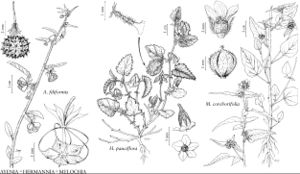Ayenia
Kongl. Svenska Vetensk. Acad. Handl. 17: 23, plate 2. 1756.
| Taxon | Illustrator ⠉ | |
|---|---|---|
 | Ayenia filiformis Hermannia pauciflora Melochia corchorifolia | Linny Heagy Linny Heagy Linny Heagy |
Subshrubs or shrubs [trees], erect, ascending, or decumbent; taprooted. Stems unarmed, hairy 3–7-veined from base. Inflorescences axillary or terminal, cymose, 1–11-flowered; epicalyx absent. Flowers bisexual [rarely unisexual or cleistogamous]; sepals basally connate, basally abaxially glandular-hairy; petals clawed, claws filiform, lamina rhombic, deltate, reniform, or ± triangular, base divided into 2 lobes or not, lobe margins entire or erose, apex notched, entire, or with 2 widely spaced teeth, surfaces glabrous or hairy, abaxial surface appendaged or not, appendage ± filiform, cylindric, or clavate, inserted in middle of lamina distally, petals inflexed toward center of flower and connivent to apex of staminal tube such that when viewed from above corolla resembles a disc with staminodes, style, and stigma, if exserted, protruding from center; androgynophore present [absent]; staminodes 5, connate into cylindric or ± rounded, minute or indistinct. Fruits capsules, often pendulous, oblate or subspheric, 5-locular, dehiscence septicidal and then loculicidal, hairy [glabrous], prickled. Seeds 1 per locule, ovoid, smooth, wrinkled, or tuberculate; endosperm absent; cotyledons leafy, folded and rolled around hypocotylar axis. x = 10.
Distribution
United States, Mexico, West Indies, Central America, South America (to Argentina and Paraguay)
Discussion
The name Ayenia pusilla Linnaeus has been misapplied to some species found in the flora area. C. L. Cristóbal (1960) selected the South American element in the Linnaean protologue of this name as lectotype; the name is now correctly applied only to a species in Ecuador and Peru.
Molecular data (B. A. Whitlock and A. M. Hale 2011) indicate that a monophyletic Ayenia is embedded within a paraphyletic Byttneria Loefling and that the monospecific, Brazilian endemic Rayleya Cristóbal is sister to a combined clade of Ayenia and Byttneria. The taxonomic implications of these relationships have not been fully resolved. A relatively small proportion of species in this Ayenia/Byttneria/Rayleya clade have been sampled and the African genus Megatritheca Cristóbal, which shows a combination of morphological features usually associated with either Ayenia or Byttneria, has not been included in molecular analyses.
The structure of Ayenia flowers is complicated and the terminology applied to the various parts has not been consistent (see L. J. Dorr 1996 and included references). In particular, the terms claw and lamina as applied to petals have been used to describe different structures. termed a gland or ligule) or not. W. Leinfellner (1960), using comparative and developmental data, argued that the rhombic, deltate, or reniform portion of the petal (lamina) is homologous with the distal part of the claw and that the lamina is reduced to an appendage or absent.
Species ca. 80 (7 in the flora).
Selected References
Lower Taxa
Key
| 1 | Petals: base of lamina lobed, apex entire or with 2 widely spaced teeth (not notched), abaxial appendage absent | > 5 |
| 1 | Petals: base of lamina attenuate on claw, apex notched, abaxial appendage present | > 2 |
| 2 | Sepals caducous (not present in young fruit); capsule prickles 0.1–0.3 mm. | Ayenia compacta |
| 2 | Sepals persistent; capsule prickles 0.3–1.5 mm | > 3 |
| 3 | Leaf blades: proximals and distals similar in shape and size, apex cuspidate; petiole (0.1–)0.2–0.5 cm; Florida. | Ayenia euphrasiifolia |
| 3 | Leaf blades: proximals and distals dissimilar in shape and size (sometimes only slightly), apex acute or subacute; petiole 0.4–1(–1.5) cm; Arizona, New Mexico, Texas | > 4 |
| 4 | Leaves: blades of proximals ovate to orbiculate, distals oblong to ovate-lanceolate or linear, base rounded to truncate, surfaces usually stellate-puberulent, sometimes glabrescent. | Ayenia filiformis |
| 4 | Leaves: blades of proximals broadly ovate to orbiculate, distals ovate to oblong-ovate or oblong-lanceolate, base cordate, surfaces moderately to sparingly hirsute, hairs usually simple, bifurcate, and fasciculate, sometimes also stellate. | Ayenia pilosa |
| 5 | Cymes borne on short shoots (brachyblasts); sepals not reflexed at anthesis; petal lamina apex with 2 widely-spaced teeth; stamen filaments present. | Ayenia microphylla |
| 5 | Cymes not borne on short shoots (brachyblasts); sepals reflexed at anthesis; petal lamina apex entire; stamen filaments absent or nearly so | > 6 |
| 6 | Leaf blades broadly ovate to ovate-lanceolate, slightly 3–5-lobed; petal lobe margins erose; androgynophore 0.5–1 mm; Arizona. | Ayenia jaliscana |
| 6 | Leaf blades ovate to ovate-lanceolate, unlobed; petal lobe margins not erose; androgynophore 0.2–0.3 mm; Texas. | Ayenia limitaris |